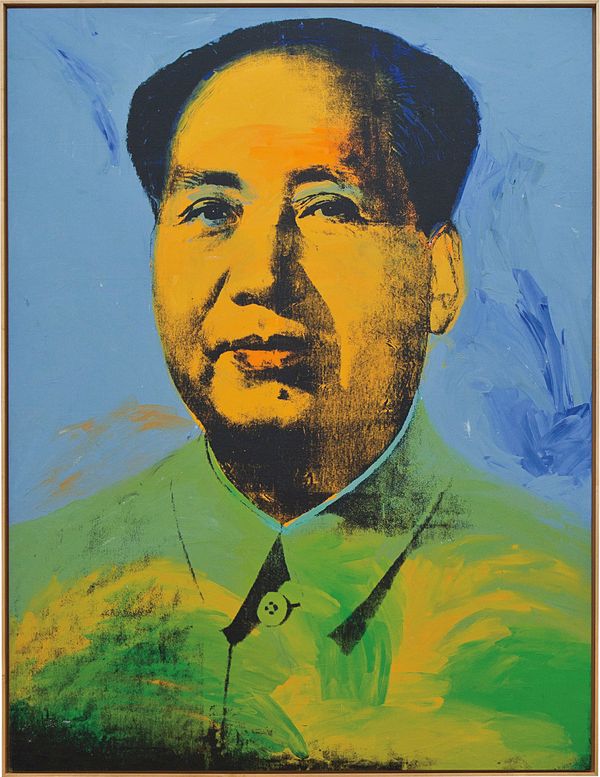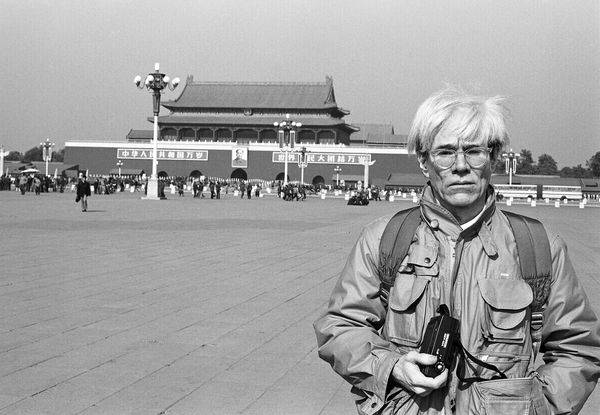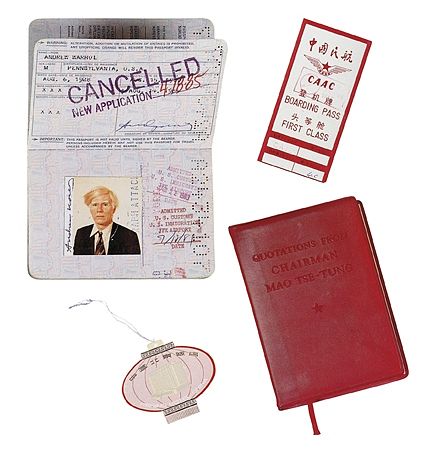Andy Warhol 20 Pink Mao's, 1979
The late 1970s and early '80s was a pivotal time for Andy Warhol, forming a period of self-refection that pushed him in critically rigorous and aesthetically potent new directions. It was then that the pioneering appropriator of pop culture turned to his own oeuvre as a resource for new creative output: amalgamating earlier series' into single Retrospective canvases, revisiting the themes of his formative Dollar Bill works with an entirely fresh iconography and creating his ominous series of Shadows that engaged with the subtle traces that all things leave behind. But it was the Reversal series where Warhol made his most direct and profound interventions.
Taking the most significant icons from his corpus such as Marilyn Monroe, the Mona Lisa, the Electric Chair and Chairman Mao, Warhol used self-appropriation to cast a new perspective on the images that seemed most familiar of all. According to author Robert Marrone, "These were the images that had made him famous — the icons, symbols and brands through which he had made his own name and which had therefore to some extent become associated with his own life, history, career and myth."
"I have been reading so much about China...The only picture they ever have is of Mao Zedong. It's great. It looks like a silkscreen"
—Andy Warhol
Above: Painting of Chairman Mao by Andy Warhol at Hamburger Bahnhof Museum of Contemporary Art in Berlin, Germany © 2016 The Andy Warhol Foundation for the Visual Arts, Inc. / Artists Right Society (ARS), New York and DACS, London. Image: Alamy Stock Photo; Below: People parade with Chairman Mao's portrait during the Cultural Revolution in Beijing circa 1970. Photo by VCG via Getty Images
Thought to be the rarest of these interpolations, and arguably the most significant, Warhol's Reversals of Chairman Mao demonstrate a shrewd recalculation of one of the world's most ubiquitous portraits. Warhol began creating paintings of Mao in 1972 using a widely circulated photograph from the Little Red Book, a pocketsized index of quotations, thoughts and citations from Chairman Mao. Following President Nixon's trip to China in 1972, Mao's image had reached an unprecedented level of international exposure. It was then that Warhol chose to direct his vision beyond America to a global audience.
Compared to Mao Tse-Tung, the icons of Warhol's 1960s portraiture were minor. As K. McShine with MoMA New York wrote in 1989, "The image of Mao taken from the portrait photograph reproduced in the Chairman's so-called Little Red Book, is probably the one most recognised by more of the earth's population than any other readymade icon, representing absolute political and cultural power. In Warhol's hands, this image could be considered ominously and universally threatening, or a parody or both."
Much like the images of Marilyn, the Reversals of Mao...live on like traces or shadows destined to repeat endlessly.
Christopher Makos' photograph of Andy Warhol in Tiananmen Square, 1982 © Christopher Makos 1982, makostudio.com
However, if in 1972 the image of Mao represented political ideology and a seemingly indomitable power, by the time Warhol revisited this motif in his Reversal series it had entirely different connotations: Mao Tse-Tung passed away in 1976, marking the end of a regime that had lasted over thirty years. Warhol's initial depictions of this Communist icon were full of painterly vitality and were depicted on a monumental scale similar to that of Mao's portrait in Tiananmen Square. This grid of twenty, however, sees the once imposing image realised with far more delicate proportions like a quiet homage to the original source: the pocket sized Little Red Book. Much like the images of Marilyn, the Reversals of Mao represent an iconographical eulogy for a once-significant public figure where the images live on like traces or shadows destined to repeat endlessly throughout the world's cultures.
Documents and ephemera from Warhol's trip to China, April 1982 © 2016 The Andy Warhol Foundation for the Visual Arts, Inc. / Artists Right Society (ARS), New York and DACS, London
By inverting the colours of his preceding originals Warhol drastically altered their mood — turning the light areas dark and highlighting the once-shadowy negative spaces. However this spectral presentation also brings the works closer to the photo-negatives that would have once been the basis of their formation, aligning the literal artifciality of production with the implied superficiality of Warhol's subjects. This evocation of the photographic negatives also references Warhol himself as a photographer and image maker, further harmonising with the evident self-referentiality of this series.
The resultant melancholic and self-analytic tone of the Reversal series reflects the brooding sensibility that had begun to pervade much of Warhol's oeuvre during this period. Morrone said, "Here, in these works, and increasingly conscious of the passing of time and his own encroaching mortality, Warhol had seemingly cast his famously cool and objective eye over subject matter that was indicative of both art and death."
Installation view of the work at Phillips Berkeley Square
This existential self-awareness followed Warhol through a succession of series of Guns, Knives and Crosses until the artist's untimely death in 1988. But by feeding off the sustenance of his own art's history, Warhol breathed new life into it, allowing his works, much like his own personal myth, to live-on endlessly in the parables of pop culture.





